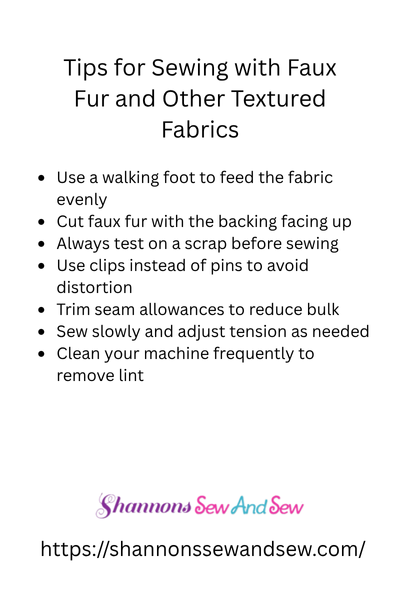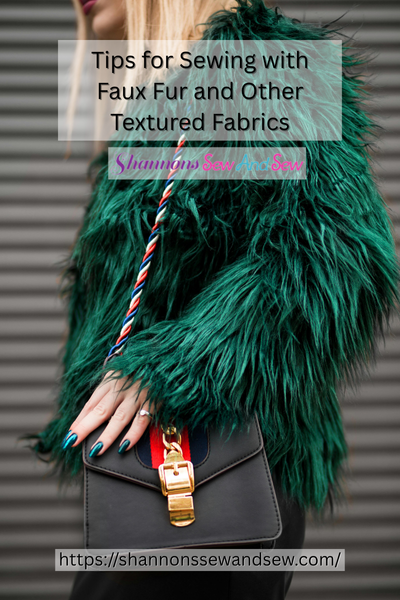Sewing Tips
Tips for Sewing with Faux Fur and Other Textured Fabrics
So, you’re staring down a yard of faux fur, wondering how on earth you’re going to tame this fuzzy beast. Trust me, you’re not alone. When I first started tackling projects with faux fur and textured fabrics, I made every mistake in the book. I once sewed the sleeve of a faux shearling jacket inside out and backwards. Twice.
But hey, that’s how we learn—and today I’m here to save you from repeating my shaggy missteps. Whether you’re sewing a cozy winter hat or adding luxe trim to a hoodie, these tips for sewing with faux fur and other textured fabrics will keep your seams straight and your sanity intact.
Read More About Tips for Sewing with Faux Fur and Other Textured Fabrics

Understand Your Fabric’s Personality
Here’s the thing about faux fur and its textured cousins (like bouclé, sherpa, or crushed velvet): they’ve got an attitude. Faux fur sheds like a golden retriever in July, bouclé loves to fray, and velvet? It’ll slip out from under your presser foot faster than your cat jumps off your lap when you sneeze.
The first of my many tips for sewing with faux fur and other textured fabrics is to spend a little time getting to know them. Run your hands over the surface. Pull at the edges. Notice how it moves. It’s like dating—only fuzzier and less expensive.
More Things to Know About Tips for Sewing with Faux Fur and Other Textured Fabrics

Cut Carefully (No, Really—Slow Down)
You can’t just slap a pattern on faux fur and go at it with your scissors like you’re wrapping Christmas gifts. Nope. You’ve got to cut with precision. Lay the fabric fur-side down, trace your pattern on the back, and then—here’s the magic—cut just the backing, not the fur itself. I like using a razor blade or a craft knife for this part.
Why? Because if you cut through the fur, you end up with blunt edges that scream “homemade” in the worst way. Plus, it sheds less if you treat it gently.
Tame the Shed Monster
Speaking of shedding, you’re going to want a lint roller on standby—and possibly a vacuum cleaner. After cutting, give your fabric a little shake-out (preferably outside unless you like your carpet hairy). Then roll away the loose fuzz.
One of my favorite tips for sewing with faux fur and other textured fabrics is to keep a handheld vacuum near your machine. You’ll thank me later when your workspace doesn’t look like a Yeti exploded.
Pin Like You Mean It
Because textured fabrics often stretch or shift, pinning becomes super important. I’m not usually a pinner—I like to live on the edge—but this is not the time to be wild and free.
Pin perpendicular to the seam so you can sew right over them if needed. Better yet, use quilting clips if your fabric is super thick. They don’t leave holes and they’re easier on your fingers.
Adjust Your Machine Settings
Here comes a game-changer: your sewing machine can’t read your mind. If you’re working with faux fur or a high-pile fabric, you’ll want a longer stitch length—try 3.5 to 4.0 mm. Short stitches can get lost in the fluff, making your seam less secure.
Also, test your tension. Sometimes, you’ll need to back it off a little so you don’t pucker the fabric. I know, I know, testing settings feels like a chore—but it saves so much grief later.
Embrace the Walking Foot
If you’ve got a walking foot attachment, this is the time to use it. Faux fur and velvet especially have a mind of their own, and the walking foot helps feed the layers evenly. If you don’t have one, don’t panic—just go slow, keep an even pressure, and don’t yank the fabric through.
Oh, and don’t forget to check your bobbin before you start a long seam. Trust me. It’s always when you’re halfway through that beast of a sleeve that your thread runs out.
Let the Fur Fly—But Trim It First
This is one of my absolute favorite tips for sewing with faux fur and other textured fabrics: after you sew your seam, flip it to the right side and use a pin or blunt needle to tease the fur back out of the seam. It makes your project look so much more polished, like you actually knew what you were doing all along.
And for fabrics like sherpa or textured fleece, trimming the seam allowance helps reduce bulk. It’s not glamorous, but it’s so worth it.
Sewing Textured Fabrics Just Got Way Less Scary
Sewing with faux fur and other textured fabrics can feel intimidating, but it’s also ridiculously rewarding. There’s something about the way a soft, fluffy collar transforms a simple coat into something you just want to pet. And hey, if a few furballs fly in the process, that’s all part of the fun, right?
I hope these tips for sewing with faux fur and other textured fabrics help you feel more confident—and maybe even excited—to dive into your next textured project. Don’t be afraid to experiment. Worst-case scenario? You end up with a slightly wonky hat and a hilarious story to share.
Got a funny faux fur fail or a textured fabric triumph? Drop it in the comments—I’d love to hear about it!




















